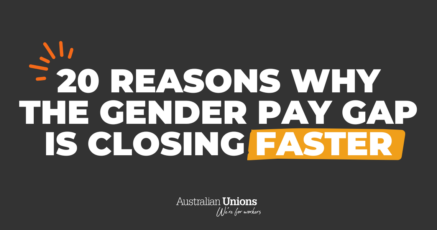It’s hard to believe we face a gender pay gap in Australia that still sees men take home an average of $263.90 more than women per week. But thanks to generations of women working together, that gap has shrunk.
The union-led campaign to obliterate the gap continues strong today and when we look back over the past couple of centuries, we can see what can be achieved when working women unite.
The efforts of working women for equal pay dates back to the 1890s, when the prolific Louisa Dunkley, campaigned on behalf of women telegraphists and postmistresses to be paid equal to men in the Post and Telegraph Department of Victoria.
A bold act of advocacy that won widespread praise, yet, despite her efforts, only granted salary increases, not pay equality.
Fast forward to the 1930s, when prominent leader and advocate for union women, Muriel Heagney, helped found the Council of Action for Equal Pay – a group of women unionists – and led their campaign for gender equity. In doing so, they were a huge influence on the Australian Council of Trade Union (ACTU)’s policy for supporting equal pay that was adopted at the 1941 congress.
The 1969 “equal pay for equal work” decision
While salary increases and policy changes progressed the equity agenda, it wasn’t until 1969 when things really started to change. Finally, the Commonwealth Conciliation and Arbitration Commission – now the Australian Industrial Relations Commission (AIRC) – recognised “equal pay for equal work” in a landmark decision brought forward by the Australasian Meat Industry Employees Union.
While this was a breakthrough decision, it highlighted systemic sexism by failing to apply to women in traditionally women-dominated roles, affecting less than 18 per cent of working women; arguably the workers most affected by equal pay in the first place.
Enter Zelda D’Aprano, union activist and prolific public speaker and writer. To secure true pay equality, Zelda famously chained herself to Melbourne’s Commonwealth Building and refused to pay the full price fare on the tram, instead paying 75 per cent, representative of the gender pay gap at the time.
The work of Zelda, Muriel and Louisa, among other formidable females, laid the foundations for the 1972 case initiated by the ACTU that resulted in the commission recognising the legal right to “equal pay for work of equal value”.
50 years on, pay equality still has a long way to go
Yet, five decades on, the fight is still alive today.
As the job market continues to evolve, and the nature of work differs vastly from industry to industry measuring “work of equal value” has only become more complicated. That’s because the jobs themselves are so different, resulting in a further widening of the gender pay gap which currently sits at 14.1% for full-time workers.
The gender pay gap
According to data released by the Workplace Gender Equality Agency (WGEA), men out-earn women across every generation, peaking at ages 55-64 where men out-earn women by more than $40,000 on average per year. However, it’s expected this number is even greater as it’s not mandatory for all companies to report to the WGEA and the organisation lacks the resources to perform its duties effectively. In order to make real change, we need to first understand the full picture of the gender pay gap across all industries and demographics in Australia.
A report by the ACTU found that men take home an average of $263.90 more than women per week. This is partially due to the failure of our system to properly recognise and value caring responsibilities – the majority of which are undertaken by women – and therefore remains financially unremunerated. Women are also more likely to be working in undervalued roles in female-dominated industries such as education and nursing, where systemic sexism is rampant, making achieving a higher income in the first place completely unattainable.
For women in higher income roles, the gender pay gap is only exacerbated as the salary increases, with senior executives taking home less than $100,000 per year on average than men.
When you consider this alongside ballooning cost-of-living, the disparity impacts Australian women’s financial freedom as they’re working harder to make ends meet with little room for discretionary spending or savings.
It’s also important to note that it’s not mandatory for all companies to report to the WGEA and that the organisation lacks the proper resources to perform effectively, which makes having a clear picture of what the gender pay gap looks like across all workplaces difficult and making change even harder.
Another factor contributing to the widening gender pay gap is pay secrecy.
Pay secrecy clauses prohibit employees from discussing their salary and remuneration, making measuring “work of equal value” near impossible – effectively silencing issues of the gender pay gap in Australian workplaces.
The union’s campaign to end pay secrecy has already seen three of the big four banks rule the clause unenforceable. However, to create systemic change, the Federal Government needs to take action to outlaw them entirely.
They also need to include Gender Equity in the Fair Work Act, implement all of the Respect@Work report recommendations and roll out public reporting of pay gaps by employers.
Being a union member is the best way to protect yourself from gender pay inequality. On average, members earn 32 per cent more than non-members. Workers in unions are also better protected from wage theft and collectively benefit from the work unions do to ensure better pay and conditions for Australian workers.







SHARE:
How far have we come with equal pay for women?